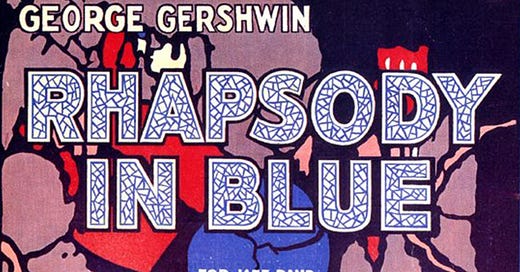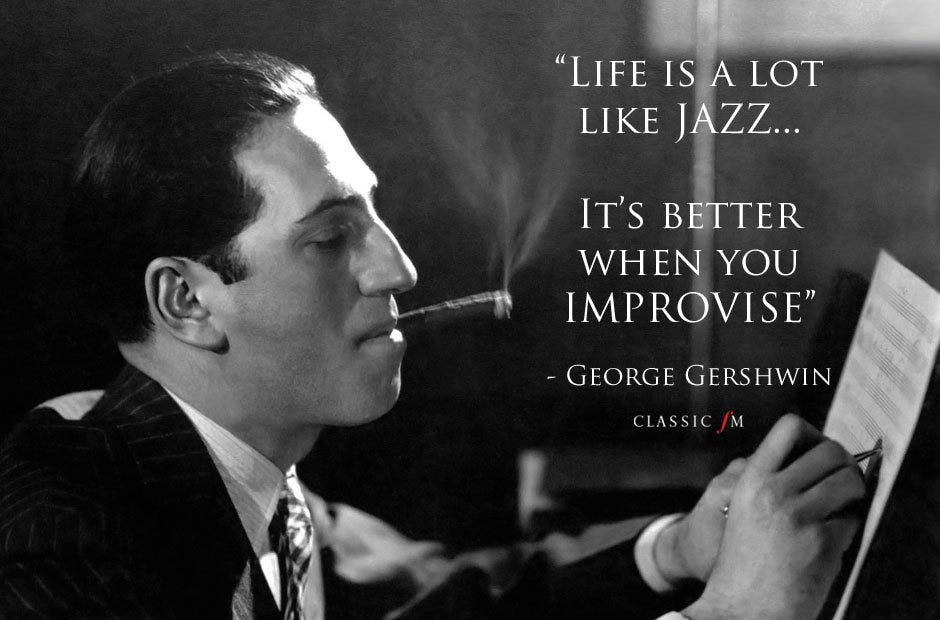Blue Century: Celebrating 100 Years of Gershwin's Iconic Rhapsody in Blue
A Tribute to the Enduring Legacy of Jazz Fusion in Classical Music
Hello and welcome to "Vintage Cafe," a reader-supported newsletter crafted for curious minds. It's my personal haven where I share my passions: music, films, books, travel, coffee, and art. To stay updated on new posts and to support my work, consider becoming either a free or paid subscriber. Opting for a paid subscription is the most impactful way to sustain and champion Vintage Cafe.
It was a hundred years ago today, on a chilly evening in New York City, February 12, 1924, that history was made at Aeolian Hall. An audacious experiment in music was about to unfold. Aeolian Hall stood as the stage for a groundbreaking event—Paul Whiteman's "An Experiment in Modern Music." Among the eclectic array of compositions slated for premiere that night, one stood out: George Gershwin's "Rhapsody in Blue."
While working on the musical comedy "Sweet Little Devil," George Gershwin found himself unexpectedly tasked with creating a jazz concerto. Whiteman's request caught Gershwin off guard, as he had only casually discussed the idea of merging jazz and classical themes with the bandleader. Gershwin was surprised that Whiteman had not kept him informed about his plans and discovered he was due to perform by reading in the newspapers. Nevertheless, challenged by the idea and the time constraints, Gershwin dove into the project with his characteristic determination and creativity.
As the audience gathered in eager anticipation, little did they know that they were on the cusp of witnessing history in the making. Gershwin, already known for his prowess in blending jazz and classical elements, had been commissioned to create a piece that would push the boundaries of musical expression. The stage was set, the air crackling with anticipation as Gershwin's fingers poised over the keys of the grand piano. With a nod to the clarinetist for the iconic opening swoop, the first notes of "Rhapsody in Blue" echoed through the hall, casting a spell over the assembled crowd.
From that moment on, time seemed to stand still as the music unfolded, weaving a tapestry of sound that defied categorization. With its seamless fusion of jazz, blues, and classical orchestration, "Rhapsody in Blue" captured the essence of a nation in flux—a vibrant, pulsating tribute to the energy and dynamism of the American spirit. Now, a century later, as we reflect on the impact of Gershwin's masterpiece, it's clear that its influence has only grown with time. From its electrifying debut at Aeolian Hall to its enduring legacy in the annals of American music, "Rhapsody in Blue" remains one of the marvels that carry the power of innovation and the enduring beauty of artistic expression.
I've witnessed this composition performed live only once in my lifetime: when pianist Simon Trpčeski performed with the Macedonian Philharmonic Orchestra, led by conductor Sasha Nikolovski Gjumar, in Novi Sad in 2005 as part of the NOMUS festival, and it was breathtaking—pure magic. And I adore it whenever I hear it—whether it's Herbie Hancock performing in a duet with Lang Lang or Leonard Bernstein's performance.
The Influence of Jazz Music on Classical Composers
Keep reading with a 7-day free trial
Subscribe to Vintage Cafe to keep reading this post and get 7 days of free access to the full post archives.






